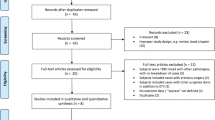Abstract
Objective
This study aims at generating knowledge to understand the conditions in which either of the two procedures (endoscopic third ventriculostomy (ETV) and shunt) are better options and to develop good practice guidelines for the treatment of tubercular meningitis (TBM) hydrocephalus.
Methods
This study was conducted on 48 patients in pediatric age group (less than or equal to 18 years) of TBM hydrocephalus. The patients were randomized to one of the cerebrospinal fluid diversion procedures (ETV or shunt). The two procedures were compared for their outcome, both radiologically and clinically.
Results
Twenty-four cases underwent shunt, out of which 13 (68 %) cases were successful. Twelve (70.3 %) cases belonged to grade 3, while one case was of grade 1. In ETV group, 10 (42 %) cases had a successful outcome, out of which 7 (38.8 %) cases were in grade 3, while 1 case each belonged to grades 1, 2, and 4. Incidence of ETV failure was more in younger age group, i.e., <2 years (n = 7), while no such correlation with age was found in shunt cases.
Conclusion
Though with the present study it looks like that the relative risk of ETV failure is higher than that for shunt, but the risk becomes progressively lower with time. Therefore, if patients survive the early high-risk period, they could experience a long-term survival advantage devoid of life-long shunt-related complications. Though for definitive comparison, a long-term study is needed




Similar content being viewed by others
References
Agrawal D, Gupta A, Mehta VS (2005) Role of shunt surgery in pediatric tubercular meningitis with hydrocephalus. Indian Pediatr 42:245–50
Chugh A, Husain M, Gupta RK, Ojha BK, Chandra A, Rastogi M (2009) Surgical outcome of tuberculous meningitis hydrocephalus treated by endoscopic third ventriculostomy: prognostic factors and postoperative neuroimaging for functional assessment of ventriculostomy. J Neurosurg Pediatr 3:371–7
Eghwrudjakpor PO, Allison AB (2010) Evolution of surgical interventions for hydrocephalus: patient preferences and the need for proper information. Internet J Med Update 5:55–62
Figaji AA, Fieggen AG, Peter JC (2007) Endoscopy for tuberculous hydrocephalus. Childs Nerv Syst 23:79–84
Husain M, Jha DK, Rastogi M, Husain N, Gupta RK (2005) Role of neuroendoscopy in the management of patients with tuberculous meningitis hydrocephalus. Neurosurg Rev 28:278–83
Husain M, Jha D, Vatsal DK, Thaman D, Gupta A, Husain N et al (2003) Neuro-endoscopic surgery—experience and outcome analysis of 102 consecutive procedures in a busy neurosurgical centre of India. Acta Neurochir 145:369–76
Jonathan A, Rajshekhar V (2005) Endoscopic third ventriculostomy for chronic hydrocephalus after tuberculous meningitis. Surg Neurol 63:32–5
Kalita J, Misra UK (1999) Outcome of tuberculous meningitis at 6 and 12 months: a multiple regression analysis. Int J Tuberc Lung Dis 3:261–5
Kemaloglu S, Ozkan U, Bukte Y, Ceviz A, Ozates M (2002) Timing of shunt surgery in childhood tuberculous meningitis with hydrocephalus. Pediatr Neurosurg 37:194–8
Lamprecht D, Schoeman J, Donald P, Hartzenberg H (2001) Ventriculoperitoneal shunting in childhood tuberculous meningitis. Br J Neurosurg 15:119–25
Marais S, Thwaites G, Schoeman JF, Torok ME, Misra UK, Prasad K et al (2010) Tuberculous meningitis: a uniform case definition for use in clinical research. Lancet Infect Dis 10:803–12
Mathew JM, Rajshekhar V, Chandy MJ (1998) Shunt surgery for poor grade patients with tuberculous meningitis and hydrocephalus: effect of response to external ventricular drainage and other factors on long-term outcome. J Neurol Neurosurg Psychiatry 65:115–8
Misra UK, Kalita J, Roy AK, Mandal SK, Srivastava M (2000) Role of clinical, radiological and neurophysiological changes in predicting the outcome of tuberculous meningitis: a multivariable analysis. J Neurol Neurosurg Psychiatry 68:300–3
Palur R, Rajshekhar V, Chandy MJ, Joseph T, Abraham J (1991) Shunt surgery for hydrocephalous in tubercular meningitis: a long-term follow-up study. J Neurosurg 74:64–9
Rajshekhar V (2009) Management of hydrocephalus in patients with tuberculous meningitis. Neurol India 57:368–74
Sil K, Chatterjee S (2008) Shunting in tuberculous meningitis: a neurosurgeon’s nightmare. Childs Nerv Syst 24:1029–32
Singh D, Kumar S (1996) Ventriculoperitoneal shunt in post tubercular hydrocephalus. Ind Pediatr 33:854–5
Singh D, Sachdev V, Singh AK, Sinha S (2005) Endoscopic third ventriculostomy in post-tuberculous meningitic hydrocephalus: a preliminary report. Minim Invasive Neurosurg 48:47–52
Srikantha U, Morab JV, Sastry S, Abraham R, Balasubramaniam A, Somanna S et al (2009) Outcome of ventriculoperitoneal shunt placement in grade IV tubercular meningitis with hydrocephalus: a retrospective analysis in 95 patients. J Neurosurg Pediatr 4:176–83
Teasdale G, Jennett B (1974) Assessment of coma and impaired consciousness. A practical scale. Lancet 2:81–4
Yadav YR, Parihar V, Agrawal M, Bhatele PR (2011) Endoscopic third ventriculostomy in tubercular meningitis with hydrocephalus. Neurol India 59:855–60
Acknowledgement
This study was funded by intramural research cell grant, King George’s Medical University, Lucknow, India.
Author information
Authors and Affiliations
Corresponding author
Rights and permissions
About this article
Cite this article
Goyal, P., Srivastava, C., Ojha, B.K. et al. A randomized study of ventriculoperitoneal shunt versus endoscopic third ventriculostomy for the management of tubercular meningitis with hydrocephalus. Childs Nerv Syst 30, 851–857 (2014). https://doi.org/10.1007/s00381-014-2371-1
Received:
Accepted:
Published:
Issue Date:
DOI: https://doi.org/10.1007/s00381-014-2371-1




